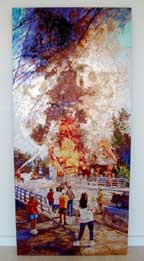The brand new gallery GASP, founded by Magda Campos-Pons, has opened in Brookline and should be a venue to watch in the coming year. For the opening debut, Evelyn Rydz has assembled Blurring Landscape where the defining of a landscape seems to be avoided in favor of more productive, open ended questions about nature and man’s relationship to his surroundings.
From ecologists to theorists, the very notion of landscape and “nature” is highly contested and often defined by a writer’s ideology. In an attempt to supply a “green theory of value” Robert Goodin argued that anything created by “natural” processes automatically possessed a higher value than ones created by artificial human ones. Significantly, he uses the analogy of fakes and forgeries in art to promote a value system where replications are never suffice to the “original.” Goodin’s theory places nature as a site that is totally external to man and further pushes the idea of “getting back” to nature and rescuing it from extinction, misuse, and replication. Can nature be identified with that part of the environment that is humanly unaffected? The polemic makes almost any interaction in the world an opportunity to de-value the landscape. The most encouraging aspect of this exhibition is the belief that reproduction can provide a valid experience that does not devalue nature or landscape, but redefines its terms for experience.
Jason Bartsch draws trees, birds and boys, personifying them with a vulnerability that is sad and endearing. In one large drawing, two trees are pointing, laughing and ridiculing a third who is balding from a gust of wind. A simple effect of the weather renders the tree defenseless and exposed, as if he had just been caught with his pants down. Nearby, three birds are seen flying out of the stomach of a crudely drawn boy. This seemingly violent act is somehow made tender by the look of relief in the boy’s face.
If Bartsch’s work seeks to find human characteristics within the landscape, Lauren Warner’s work revels in a detached, mediated depiction. Warner’s paintings of exploding geysers are at once orgasmic and totally banal. Painted from photographs of National parks, these paintings do not attempt to show the force of the original explosion, only its photographic residue. Warner’s paintings suggest that the reproduction of landscape could very well represent the only access to nature we have left. However, Warner’s work suggests that a mediated access to nature does not mean a less valuable experience of it.
Crafted out of insulation foam, Hillary Baldwin’s rocks and skulls delight in their reproduction. The casual littering of her carvings call to mind an excavation site where the major finds is still lingering with the rubble. Like Warner, her artificial replicas are not inferior to any “original”, but call attention to the artifice of the whole polemic. Her charming constructions of model bridges and logs next to painted faces on spilled paint succeed in enticing the viewer into her fabricated world and constructed landscape.
Like Baldwin, Brian Burkhardt makes reproductions. Crafted out of a host of materials too long to list, his ecological specimens are very convincing as “real” dead things. The squid on display has jumped out of its blue formaldehyde jar and appears freshly splatted on the floor near the pedestal. As in Bartsch’s work, the potentially gruesome scene is more vulnerable than expected, as the welfare of the squid becomes disconcerting. The squid has a wet likeness and freshness that caused some concern for this viewer. The piece reiterates that what is ‘natural’ is often constructed by the hands of man, in this case scientists, or artists.
Landscapes on fire are the subject for Jamie Vasta’s “paintings.” These sensationalist depictions of “nature” are photographs of burning forests and houses rendered in glitter. While the forest fire may be ‘natural’, its circulation and consumption through photography has also been naturalized. Likewise for images of burning houses and the depiction of human suffering. Vasta’s use of glitter reiterates and negotiates this dynamic by simultaneously deflecting and seducing the viewer’s gaze.
Evelyn Rydz plays a double role for the show as both participant and curator. Line and implied texture define her piece as squiggles carve into the surface of the wood panel, and then undulate with paint globs on the surface. Her landscape is in constant negotiation with the surface of the piece, both reiterating and revealing the frame of painting- a dominant site where landscape resides.
Blurring Landscape shows little urgency to illustrate that landscape and nature are categories constructed by ideologies, rather it takes it as a given. These six artists seem to prefer the simulated version of landscape to any original ideal. Their reproductions give evidence that rather than devalue nature, a replication also has a validating experience. After all, going back to nature to escape its amazing commodification seems rather constrictive.
"Blurring Landscape" is on view at Gallery Artist Studio Projects (GASP), located at 362 Boylston St., Brookline, until October 22nd.
All images are courtesy of the artist and GASP.
Micah J. Malone is a regular contributor to Big, Red & Shiny.




